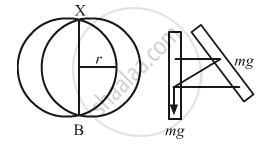Advertisements
Advertisements
प्रश्न
A closed circular wire hung on a nail in a wall undergoes small oscillations of amplitude 20 and time period 2 s. Find (a) the radius of the circular wire, (b) the speed of the particle farthest away from the point of suspension as it goes through its mean position, (c) the acceleration of this particle as it goes through its mean position and (d) the acceleration of this particle when it is at an extreme position. Take g = π2 m/s2.
उत्तर
It is given that:
Time period of oscillation, T = 2 s
Acceleration due to gravity, g =\[\pi^2\]ms−2
Let I be the moment of inertia of the circular wire having mass m and radius r.

(a) Time period of compound pendulum \[\left( T \right)\] is given by ,
\[T = 2\sqrt{\frac{I}{mgl}} = 2\sqrt{\frac{I}{mgr}}\]
\[\left( \because l = r \right)\] ...(1)
Moment of inertia about the point of suspension is calculated as,
I = mr2 + mr2 = 2mr2
On substituting the value of moment of inertia I in equation (1), we get:
\[T = 2\pi\sqrt{\frac{2m r^2}{mgr}} = 2\pi\sqrt{\frac{2r}{g}}\]
\[ \Rightarrow \frac{2}{2\pi} = \sqrt{\frac{2r}{g}}\]
\[ \Rightarrow \frac{2r}{g} = \frac{1}{\pi^2}\]
\[ \Rightarrow r = \frac{g}{2 \pi^2}\]
\[ = 0 . 5 m = 50 cm\]
(b) From the energy equation, we have:
\[\frac{1}{2}I \omega^2 - 0 = mgr \left( 1 - \cos \theta \right)\]
\[\frac{1}{2}I \omega^2 - 0 = mgr \left( 1 - \cos 2^\circ \right)\]
\[\Rightarrow \left( \frac{1}{2} \right)2m r^2 \cdot \omega^2 = mgr\left( 1 - \cos 2^\circ\right) \left( \because I = 2m r^2 \right)\]
\[ \Rightarrow \omega^2 = \frac{g}{r}\left( 1 - \cos 2^\circ\right)\]
\[\text { On substituing the value of g and r in the above equation, we get:}\] \[\omega = 0 . 11 rad/s\]
\[ \Rightarrow v = \omega \times 2r = 11 {\text { cms }}^{- 1}\]
(c) The acceleration is found to be centripetal at the extreme position.
Centripetal acceleration at the extreme position \[\left( a_n \right)\] is given by,
an = ω2(2r) = (0.11) × 100 = 12 cm/s2
The direction of an is towards the point of suspension.
(d) The particle has zero centripetal acceleration at the extreme position. However, the particle will still have acceleration due to the S.H.M.
Angular frequency \[\left( \omega \right)\] is given by ,
\[\omega = \frac{2\pi}{T}\]
\[ = \frac{2\pi}{2} = 3 . 14\]
\[\therefore\] Angular Accelaration \[\left( a \right)\] at the extrame position is given as ,
\[\alpha = \omega^2 \theta\]
\[\alpha = \omega^2 2^\circ= \pi^2 \times \frac{2\pi}{180}\]
\[ = \frac{2 \pi^3}{180} \left[ 1^\circ= \frac{\pi}{180}\text { radian } \right]\]
Thus , tangential acceleration
\[= \alpha\left( 2r \right) = \left( \frac{2 \pi^3}{180} \right) \times 100\]
= 34 cm/s2
APPEARS IN
संबंधित प्रश्न
State the differential equation of linear simple harmonic motion.
Can simple harmonic motion take place in a non-inertial frame? If yes, should the ratio of the force applied with the displacement be constant?
A particle executes simple harmonic motion Let P be a point near the mean position and Q be a point near an extreme. The speed of the particle at P is larger than the speed at Q. Still the particle crosses Pand Q equal number of times in a given time interval. Does it make you unhappy?
It is proposed to move a particle in simple harmonic motion on a rough horizontal surface by applying an external force along the line of motion. Sketch the graph of the applied force against the position of the particle. Note that the applied force has two values for a given position depending on whether the particle is moving in positive or negative direction.
The time period of a particle in simple harmonic motion is equal to the time between consecutive appearances of the particle at a particular point in its motion. This point is
The motion of a particle is given by x = A sin ωt + B cos ωt. The motion of the particle is
A pendulum clock keeping correct time is taken to high altitudes,
Which of the following quantities are always zero in a simple harmonic motion?
(a) \[\vec{F} \times \vec{a} .\]
(b) \[\vec{v} \times \vec{r} .\]
(c) \[\vec{a} \times \vec{r} .\]
(d) \[\vec{F} \times \vec{r} .\]
Suppose a tunnel is dug along a diameter of the earth. A particle is dropped from a point, a distance h directly above the tunnel. The motion of the particle as seen from the earth is
(a) simple harmonic
(b) parabolic
(c) on a straight line
(d) periodic
A particle moves on the X-axis according to the equation x = x0 sin2 ωt. The motion is simple harmonic
In a simple harmonic motion
A pendulum clock giving correct time at a place where g = 9.800 m/s2 is taken to another place where it loses 24 seconds during 24 hours. Find the value of g at this new place.
A simple pendulum is constructed by hanging a heavy ball by a 5.0 m long string. It undergoes small oscillations. (a) How many oscillations does it make per second? (b) What will be the frequency if the system is taken on the moon where acceleration due to gravitation of the moon is 1.67 m/s2?
A simple pendulum fixed in a car has a time period of 4 seconds when the car is moving uniformly on a horizontal road. When the accelerator is pressed, the time period changes to 3.99 seconds. Making an approximate analysis, find the acceleration of the car.
A hollow sphere of radius 2 cm is attached to an 18 cm long thread to make a pendulum. Find the time period of oscillation of this pendulum. How does it differ from the time period calculated using the formula for a simple pendulum?
A particle executing SHM crosses points A and B with the same velocity. Having taken 3 s in passing from A to B, it returns to B after another 3 s. The time period is ____________.
Define the frequency of simple harmonic motion.
Write short notes on two springs connected in series.
State the laws of the simple pendulum?
A body having specific charge 8 µC/g is resting on a frictionless plane at a distance 10 cm from the wall (as shown in the figure). It starts moving towards the wall when a uniform electric field of 100 V/m is applied horizontally toward the wall. If the collision of the body with the wall is perfectly elastic, then the time period of the motion will be ______ s.

